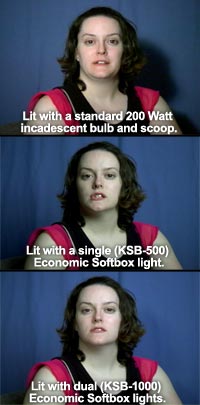Once you have the lights where you want them, adjusting them and aiming them is very easy. They adjust up to nine feet in height, which allows you get a little height on a scene if you need to. (The boom arm for the smaller softbox in the KSB-1250 will presumably let you get even higher, but I’m sure this setup would require sandbag placement to prevent the rig from becoming overly top heavy.)
Depth of Options
Soft boxes are never lights that give you a huge number of options, as they are designed to throw a lot of diffuse light on a scene, rather than have the pinpoint accuracy that’s seen in more conventional video and film lights. As I mentioned before, the height options give you some variance, as can additional distance. However, due to the less powerful bulbs used in these lights, additional distance is often not the best option, as due to the quickness of light falloff.
 They experimented with the idea of putting a second sheet of diffusion inside the softbox, to allow one light to be softer than the other without requiring the light be moved away from the action. However, they found that the hotter bulbs that are used in the KSB series, caused this second sheet of diffusion to become too hot for use. (Because we received the pre-production version, we accidentally received the internal diffusion they had been testing as well.) The idea is great but because of the internal temperature issue, it would be great to see an outer silk diffusion included. This would be slightly larger than the face of the soft box and could velcro to the outside of the softbox to give you the double diffusion that you may want in certain situations.
They experimented with the idea of putting a second sheet of diffusion inside the softbox, to allow one light to be softer than the other without requiring the light be moved away from the action. However, they found that the hotter bulbs that are used in the KSB series, caused this second sheet of diffusion to become too hot for use. (Because we received the pre-production version, we accidentally received the internal diffusion they had been testing as well.) The idea is great but because of the internal temperature issue, it would be great to see an outer silk diffusion included. This would be slightly larger than the face of the soft box and could velcro to the outside of the softbox to give you the double diffusion that you may want in certain situations.
The bulbs that come with this package are 500W bulbs (or 250W for the top light in the KSB-1250) which are balanced at the 3200K tungsten light temperature, meaning that they are balanced perfectly to simulate artificial, indoor lighting. If you wish to use these lights to replicate daylight, you can pick up a set of 5200K temperature fluorescent bulbs directly from Smith-Victor, which worked quite well in our tests. They’re especially useful if you need to light in an indoor location that you want to look as though it was all naturally lit. (Be aware that daylight temperature bulbs have a blue hue, which, in a fluorescent bulb, appears a bit soft and watery to the human eye. However, once you white balance your camera accordingly, colors actually pop a little more with these daylight bulbs.)
One thing I would love to see in a future version of this series is a squared surrounding scoop which would wrap around the bulb and which the material of the softbox would extend from. If this can be done without posing a fire risk, then it could behave like a camera matte box. This would allow filmmakers to put in rigid colored filters and have additional color options.